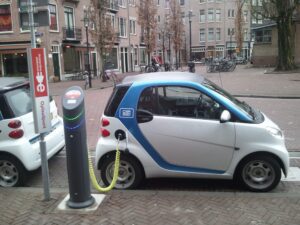Smart cities represent both an exciting leap forward for humanity and an important step in achieving the Sustainable Development Goals (SDGs). With the potential to reduce urban poverty, improve air quality, and increase access to clean energy, smart cities are a growing trend in sustainable urban development.
The advancement of technology is key to the creation of smart cities. For example, new applications such as smart grids allow for efficient energy usage and can help reduce emissions. Other technologies such as digital water systems can help ensure safe drinking water for city residents while conserving resources. Furthermore, data-driven systems such as traffic management are being used to reduce congestion and optimise public transportation schedules. These advances all contribute to creating sustainable cities that are better equipped to face environmental challenges.
By providing real-time data and information on public resources, digital technology is enabling citizens to make informed decisions about their urban environments and contribute to more efficient use of resources. Utilising existing infrastructure and investing in new technology solutions, smart cities can help achieve sustainable development goals such as zero hunger, clean water and sanitation, affordable housing, climate action, responsible consumption and production patterns, clean energy, and economic growth.
Smart city initiatives have already been implemented in many countries around the world, proving the feasibility of sustainable development in urban areas. Requiring continued commitment by governments and city leaders, investing in smart city projects is essential if we want a sustainable future for our planet.
Examples of Smart Cities & the Innovative Technologies Required:
As technology continues to advance, smart cities are becoming increasingly popular. Smart cities use various technologies, such as the Internet of Things (IoT), big data, artificial intelligence (AI), robotics, cloud computing, and 5G networks, to improve services for citizens and businesses.
Singapore
One famous example of a smart city is the country and city-state of Singapore. The city has been investing in innovative technology since its early days in order to create an urban environment that is both efficient and sustainable. The government has implemented numerous initiatives to make transportation quicker and cleaner by using GPS tracking systems for buses and taxis, introducing electric vehicles on its roads, creating underground highways for freight trucks, and providing bike lanes throughout the city. In addition to this, the government has created a range of digital services such as online healthcare and digital payment systems, to make life easier for the citizens.
London
Another notable example is London, which has adopted a number of smart city initiatives in order to reduce traffic congestion and air pollution. These include using sensors and cameras to monitor traffic flow in real-time, introducing electric buses and taxis, providing Wi-Fi hotspots throughout the city and offering an online platform where citizens can report problems or access important information. Ultimately, these initiatives have helped make London one of the most technologically advanced cities in the world.
Amsterdam
Amsterdam is yet another example of a successful smart city. The Dutch capital has implemented numerous programs such as smart energy grids, water management systems, connected parking systems, automated waste collection and green transportation options, to make life easier for its citizens and businesses. This has resulted in a more efficient, sustainable and liveable city.
These are just some of the famous examples of smart cities that have implemented innovative technologies to improve services and reduce environmental impact. Smart cities around the world continue to invest in new technologies as well as create digital platforms for citizens, in order to provide better access to services and ultimately enhance urban life.
Concluding thoughts…
The design and implementation of smart cities is a highly complex process. It requires policymakers to draw upon evidence-based solutions to tackle a diverse range of pressing and long-term urban challenges such as climate change, poverty alleviation, energy efficiency and urban mobility. Both long-term sustainability goals and short-term objectives must be kept in mind. This means investing in infrastructure that is resilient and efficient, engaging citizens as partners in development, accessing reliable data sources to inform decision making, and leveraging technology for finding better solutions to existing challenges. Ultimately, by incorporating sustainable practices into urban planning from the start, smart cities can create an environment where people live safely and securely while reducing their environmental impact.






